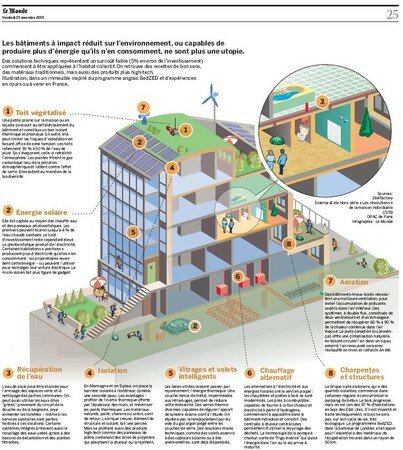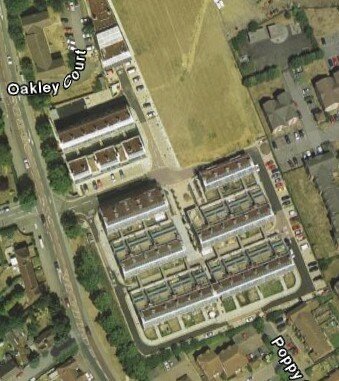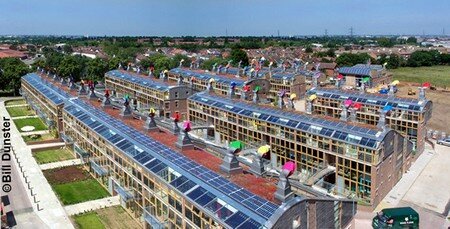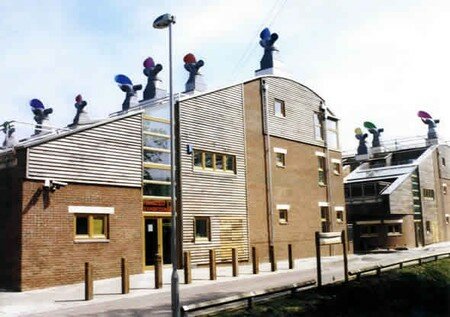BEDZED
A beautiful example of project "Sustainable development": : Beddington Zero Energy Development (BedZED), the first the biggest eco-community in England, created in Mars 2002.
This article is in English (extracted from the site of the builder(manufacturer) http: // www.peabody.org.uk) so that my mother, an English teacher in a grammar school, can have a survey with her pupils and why not organize a school trip there for a change instead of visiting the traditional Canterbury ....!
Besides the opening on England and English language, that can allow to make sensitive the young people on the ecological stakes in the sustainable development.
The site BedZED organizes conducted tours. For those who are interested, click ici.
(and for a detailed article in French for the non-polyglots, click ici)
BedZED has become an excellent learning centre for sustainable development, attracting considerable local, national and international media coverage and interest.
Place : Helios Road, Wallington, Surrey, SM6 (London Borough of Sutton)
Vue satellite Google Earth
BedZED's architecture
BedZED has been designed to address environmental, social and economic needs. It brings together a number of proven methods - none of them particularly high tech - of reducing energy, water and car use. Crucially, it produces affordable, attractive and environmentally responsible housing and workspace.
Key features include:
Using renewable materials
Where possible, BedZED is built from natural, recycled or reclaimed materials. All the wood used has been approved by the Forest Stewardship Council or comparable internationally recognised environmental organisations, to ensure that it comes from a sustainable source.
Space heating
Through the innovative design and construction, heat from the sun and heat generated by occupants and every day activities such as cooking is sufficient to heat BedZED homes to a comfortable temperature. The need for space heating, which accounts for a significant part of the energy demand in conventional buildings, is therefore reduced or completely eliminated.
BedZED homes and offices are fitted with low energy lighting and energy efficient appliances to reduce electricity requirements.
To enable residents and workers to keep track of their heat and electricity use, meters are mounted in each home and office kitchen.
Combined heat and power plant
BedZED receives power from a small-scale combined heat and power plant (CHP). In conventional energy generation, the heat that is produced as a by-product of generating electricity is lost. With CHP technology, this heat can be harnessed and put to use.
At BedZED, the heat from the CHP provides hot water, which is distributed around the site via a district heating system of super-insulated pipes. Should residents or workers require a heating boost, each home or office has a domestic hot water tank that doubles as a radiator.
The CHP plant at BedZED is powered by off-cuts from tree surgery waste that would otherwise go to landfill. Wood is a carbon neutral fuel because the CO2 released when the wood is burned is equal to that absorbed by the tree as it grew.
Green transport plan
Transport energy accounts for a large proportion of the energy consumption of any development.
A green transport plan promotes walking, cycling and use of public transport. A car pool for residents has been established, and all these initiatives have helped to provide a strategic and integrated approach to transport issues.
The BedZED project shows that it is possible to reduce reliance on cars and introduced the first legally binding Green Transport Plan as a condition of planning permission.
BedZED’s target is a 50% reduction in fossil-fuel consumption by private car use over the next ten years compared with a conventional development.
BedZED has been designed to encourage alternatives to car use.
BedZED has good public transport links, including two railway stations, two bus routes and a tramlink.
An onsite Car Club called ‘ZEDcars’. BedZED was the first low car development in the UK to incorporate a car club: a car club established to reduce car ownership and improve accessibility for those who are unable to afford a car.
A ‘pedestrian first’ policy with good lighting, drop kerbs for prams and wheelchairs and a road layout that keeps vehicles to walking speed.
BedZED is designed along ‘homezone’ principles that have benefited communities in continental Europe for many years
On-site charging points for electric cars and a free public electric vehicle charging point is already available in Sutton town centre. BedZED’s 10-year target is to produce enough electricity from photovoltaic panels (which convert sunlight into energy) to power 40 electric vehicles. It is hoped that a mixture of private cars and vehicles available through the car club will minimise fossil fuel use as the community settles. For owners of electric vehicles energy and parking will be free of charge.
Reducing ‘embodied’ energy
Embodied energy is a measure of the energy required to manufacture a product. A product that requires large amounts of energy to obtain and process the necessary raw materials, or a product that is transported long distances during processing or to market, will have a high-embodied energy level.
To reduce the embodied energy of BedZED, construction materials were selected for their low embodied energy and sourced within a 35-mile radius of the site where possible. The energy expended in transporting materials to the site was therefore minimised.
Results
Numerous lessons were learnt during the construction of BedZED and in the years since residents first moved in during March 2002.
The surrounding community was consulted during the development process and the new community has integrated well. The new residents are proud of where they live and consider that they are living somewhere special.
Thanks to the commitment of residents, design innovation and social initiatives, a strong community at BedZED was established quickly. Reductions in energy and water consumption during construction have been supported by consumption figures during occupation that are way below UK averages.
The scheme has enabled residents to live a sustainable lifestyle without making severe demands on routines.
BedZED demonstrates that comfortable, attractive, affordable and energy efficient buildings are the homes and workplaces of the future.
BedZED is a mixed-use, mixed-tenure development that incorporates innovative approaches to energy conservation and environmental sustainability.
Background
The BedZED design concept was driven by the desire to create a net ‘zero fossil energy development’, one that will produce at least as much energy from renewable sources as it consumes. Only energy from renewable sources is used to meet the energy needs of the development. BedZED is therefore a carbon neutral development - resulting in no net addition of carbon dioxide to the atmosphere.
What are the features of BedZED?
The design is to a very high standard and is used to enhance the environmental dimensions, with strong emphasis on roof gardens, sunlight, solar energy, reduction of energy consumption and waste water recycling.
The homes are a mixture of sizes and the project also includes buildings for commercial use, an exhibition centre, a children's nursery and a show flat so that visitors may see what it is like to live at BedZED.
The buildings
Buildings are constructed from thermally massive materials that store heat during warm conditions and release heat at cooler times. In addition, all buildings are enclosed in a 300mm insulation jacket.
BedZED houses are arranged in south facing terraces to maximise heat gain from the sun, known as passive solar gain. Each terrace is backed by north facing offices, where minimal solar gain reduces the tendency to overheat and the need for energy hungry air conditioning.








/https%3A%2F%2Fassets.over-blog.com%2Ft%2Fcedistic%2Fcamera.png)
/https%3A%2F%2Fstorage.canalblog.com%2F93%2F67%2F300583%2F79583573_o.jpg)
/http%3A%2F%2Fstatic.guim.co.uk%2Fsys-images%2FGuardian%2FAbout%2FGeneral%2F2012%2F9%2F21%2F1348231350306%2FBig-picture-Spill-008.jpg)
/http%3A%2F%2Fstatic.guim.co.uk%2Fsys-images%2FGuardian%2FPix%2Fpictures%2F2012%2F2%2F27%2F1330343060996%2FDan-Lepard-byline-pic-003.jpg)